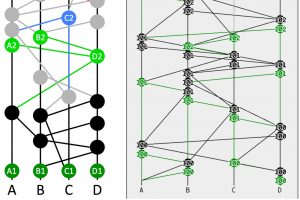Hashgraph is a consensus algorithm used to build and run shared worlds – fully distributed applications that harness the power of the cloud without servers. This algorithm was open sourced under Apache 2.0 license in 2022 to enable broader community participation. Now anyone can develop applications that rapidly achieve consensus, resulting in secure, stable, and sustainable transactions at a fraction of the cost of traditional server-based platforms, without any single point of failure.
Hedera is the only public ledger – a highly secure and distributed database that everyone can read from and write to – that uses hashgraph consensus, a faster, more secure alternative to blockchain consensus mechanisms. The ledger consists of the platform, a network comprised of consensus and mirror nodes, as well as network services, a set of APIs that allow you to create accounts, mint tokens, write data to the ledger, call smart contracts, and other functions.
From the team that founded and built out Hedera, Swirlds Labs now leads the development of the Hedera platform and network services, and will be building open source components that enable faster deployment of industry solutions. From the brain of Dr. Leemon Baird, the inventor of hashgraph, Swirlds Labs’ ‘moonshot’ projects will change the way humans and organizations have privacy, security, and trust in their shared worlds.
Resources

Hashgraph Consensus: Fair, Fast, Byzantine Fault Tolerance
A new system, the Swirlds hashgraph consensus algorithm, is proposed for replicated state machines with guaranteed Byzantine fault tolerance. It achieves fairness, in the sense that it is difficult for an attacker to manipulate which of two transactions will be chosen to be first in the consensus order. It has complete asynchrony, no leaders, no round robin, no proof-of-work, eventual consensus with probability one, and high speed in the absence of faults. It is based on a gossip protocol, in which the participants don’t just gossip about transactions. They gossip about gossip. They jointly build a hashgraph reflecting all of the gossip events. This allows Byzantine agreement to be achieved through virtual voting. Alice does not send Bob a vote over the Internet. Instead, Bob calculates what vote Alice would have sent, based on his knowledge of what Alice knows. This yields fair Byzantine agreement on a total order for all transactions, with very little communication overhead beyond the transactions themselves.

Hashgraph Consensus: Detailed Examples
The Swirlds hashgraph consensus algorithm is explained through a series of examples on a hashgraph. Each page shows the hashgraph with annotations explaining a step of the algorithm. This covers the core algorithm, from creating transactions through finding their consensus order and timestamps.

Overview of Swirlds Hashgraph
The hashgraph data structure and Swirlds consensus algorithm provide a new platform for distributed consensus. This paper gives an overview of some of its properties, and comparisons with the Bitcoin blockchain. In this paper, the term “blockchain” will generally refer to the system used in Bitcoin, rather than the large number of variants that have been proposed.
The goal of a distributed consensus algorithm is to allow a community of users to come to an agreement on the order in which some of them generated transactions, when no single member is trusted by everyone. In this way, it is a system for generating trust, when individuals do not already trust each other…

Dictatorship, Democracy, and Blockchain
Much has been said about the democratization of technology and how the internet, mobile phones and social media can level the information age playing field. But technology can be an equalizer on a more fundamental level — that of trust. Distributed consensus algorithms enable communities of people, strangers who are both unknown and untrusted, to securely collaborate with each other over the internet without the need for a trusted central server. In the past few years more than a billion dollars have been invested in this type of technology. But why? Why is distributed consensus important? The answer can be found by looking at the differences between a dictatorship and a democracy.

Hashgraph consensus aBFT proof in Coq
The hashgraph consensus algorithm is Asynchronous Byzantine Fault Tolerant (aBFT). This was proved in the 2016 technical report, using words and equations that a human can read. That proof has now been formalized: translated into a form that allows a computer to check the proof. This was done in the Coq proof assistant. Download the zip file to see all of the definitions, lemmas, theorems, and proofs in Coq format, along with instructions for installing Coq. The proofs can then be loaded into Coq, and it will verify that they are correct.



